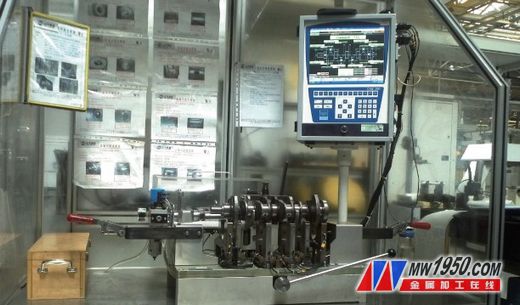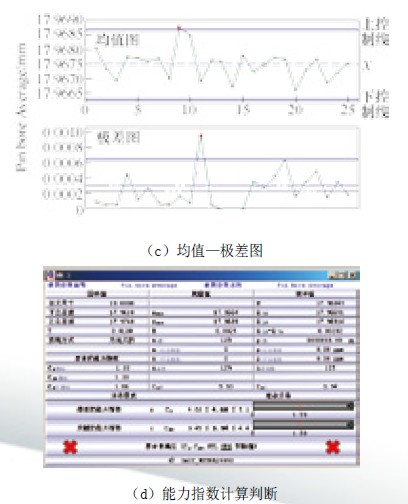Both ISO9000 and ISO/TS16949 standards require organizations to determine the appropriate method and extent of application of statistical techniques. It is required in the Production Part Approval Process (PPAP Manual) that it is acceptable to determine the initial process capability or performance level during the initial process study, which requires both the initial production phase and the mass production phase. The appropriate statistical process control (SPC) technique is used to verify that its process capability responds to insufficient or unstable statistical capabilities and initiates a response plan in the control plan.

This paper points out the shortcomings of applying SPC technology in the metal processing production process according to the SPC Handbook. At the same time, it gives a real-time SPC monitoring method for the machining process of the engine and its parts, and carries out effective process quality control on the product.
Insufficient SPC technology
According to the SPC Handbook, we have summarized the process of implementing SPC for metal processing features, as shown in Figure 1.

Figure 1 Flow chart of machining SPC in an engine factory
1) KPC (Key Features) project.
2) Projects that are not 100% inspected.
3) It is not a project to be sent to the laboratory to ensure that the test data is obtained in a timely manner.
4) It is not a visual inspection and inspection program to ensure that the process characteristics are measured values.
5) The on-site inspection tool is an industrial computer with SPC function, which avoids manual statistical calculation and drawing.
Figure 2 shows an example of an SPC for real-time process monitoring after determining the control limits in the SPC manual. The figure is generated by Q-DAS? statistical analysis software, and four images are generated simultaneously on the same interface, as shown in Figure 2.
As can be seen from Figure 2, the entire sample distribution range is about 1/5 of the total tolerance and is distributed in the center of the tolerance with a capability index of 3.94. For such a control chart, it should be quite good intuitively, but the control chart has issued an alarm because there are two points on the mean-extreme chart (Fig. 2c) that exceed the control limit, and the discrete picture is unstable, according to SPC. The manual requires that the cause of the anomaly be analyzed and appropriate measures taken. Because it is the discrete upper limit, it is difficult to find the real reason, and because the process capability index is as high as 3.94, the staff are not willing to spend energy to find the reason, and there is no possibility to improve the SPC control in the alarm response. "Failed".


With the continuous improvement of China's basic equipment level and the introduction of foreign advanced equipment, although the process capability in this example is very high, there are more and more cases of frequent alarms when monitored by conventional SPC. For such an alarm, in order to prevent over-adjustment, the processing method is basically "no action".
LG Sigma Elevator Spare Parts, LG Elevator Spare Parts, Sigma Elevator Spare Parts
Sigma Elevator Company is a subsidiary of Otis Elevator Korea (OEK) in South Korea for all overseas/export markets. It was founded in 2000.
Starting in 1968, "Goldstar" elevators, and later on, "LG" elevators, were counted among the world's top elevator brands. With the beginning of this new millennium, that legacy lives on through the birth of "SIGMA" elevators.
SIGMA Elevator Company will continue on with its mission of supplying elevators and escalators to more than 50 nations worldwide through its global network of 11 sales companies, 2 offices, and 52 agents or distributors.
SIGMA Elevator Company is dedicated to providing its customers with the best quality products and services. SIGMA elevators feature unmatched safety, ride comfort, and modern design. SIGMA escalators and moving walkways are held to similar safety and comfort standards and are integral parts of our modern urban aesthetics.
Changwon factory, Korea, the main factory of SIGMA Elevator, has long been a well-established name in the global elevator industry. SIGMA`s Dalian factory in China produces elevators & escalators to meet the demands of the local and worldwide markets as well.
SIGMA Elevator Company is committed to increasing customer value through a sharp focus on product innovation and customer satisfaction. With technology developed over the past 30 years, an enduring innovative spirit, and enthusiastic attitude towards providing customer value, Sigma Elevator Company stands by its product and service lines with confidence.
Sigma currently has businesses in more than 75 countries worldwide, and subsidiaries in five countries; Hong Kong (China), Vietnam, Thailand, Malaysia and Singapore.
In the United States, Sigma elevators were distributed by CemcoLift, which was a historic elevator company bought by Otis and based in Hatfield, PA. However, in 2012 CemcoLift has gone bankrupt and replaced by a new company called Minnesota Elevator Solutions.
It's headquarter, factory and testing tower are located in Changwon, South Korea, which are also operated by Otis Elevator Korea. It also has a secondary factory in Dalian, China, opened in 1998 to meet demands on Chinese elevator market.
In 2014, Sigma had a partnership with EXPRESS Elevator Co., Ltd., an elevator company based in Suzhou, China as well as a subsidiary of Otis. In 2016, Express/Sigma opened their headquarters in Suzhou, China
LG Elevators was the elevator and escalator division of LG Electronics. It was acquired by Otis in 1999 and was later known as LG-OTIS Elevator Company.
LG changed its name from GoldStar in 1994 after GoldStar merged with Lucky Chemical. In 1999, it was acquired by Otis Elevator Company, later known as LG-OTIS Elevator Company from 2000 until 2003, when it was renamed to OTIS-LG Elevator Company. Later in 2006, OTIS-LG was again renamed to Otis Elevator Korea.
LG-OTIS Elevator Company (later OTIS-LG Elevator Company then Otis Elevator Korea) was a joint venture company between Otis and LG Electronics` elevator and escalator division, LG Elevators in South Korea. It was formed in 2000. The brand was renamed to OTIS-LG Elevator Company in 2003 and later Otis Elevator Korea in 2006, where it is currently known as that in South Korea
LG Sigma Elevator Spare Parts, LG Elevator Spare Parts, Sigma Elevator Spare Parts
CEP Elevator Products ( China ) Co., Ltd. , https://www.zjelevatordoorsystem.com
